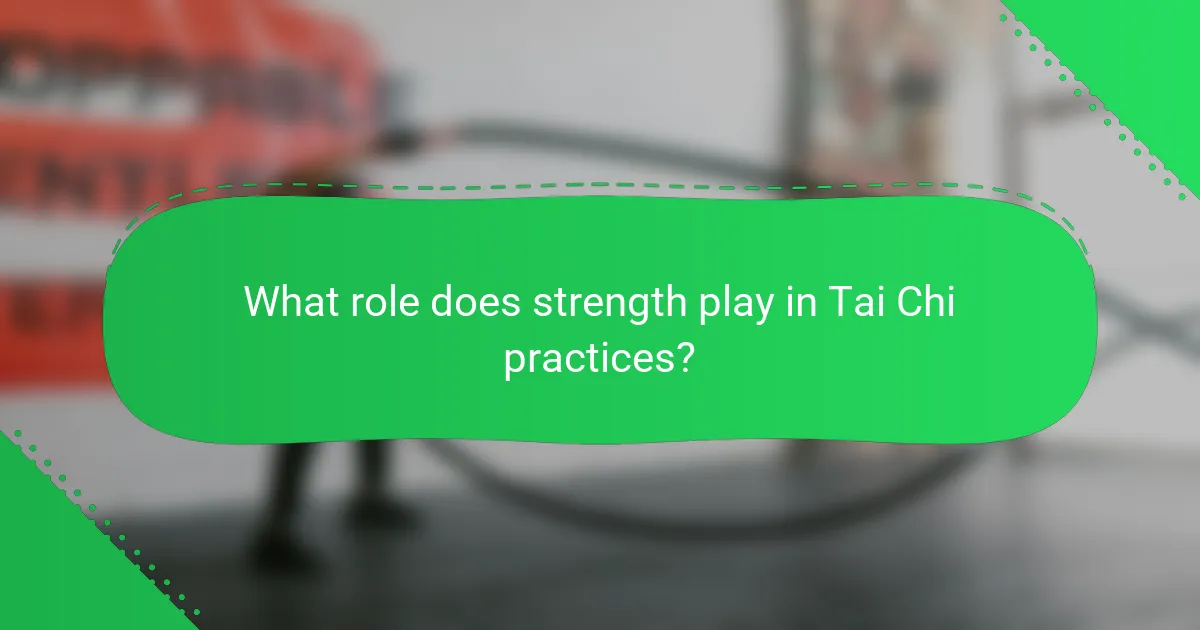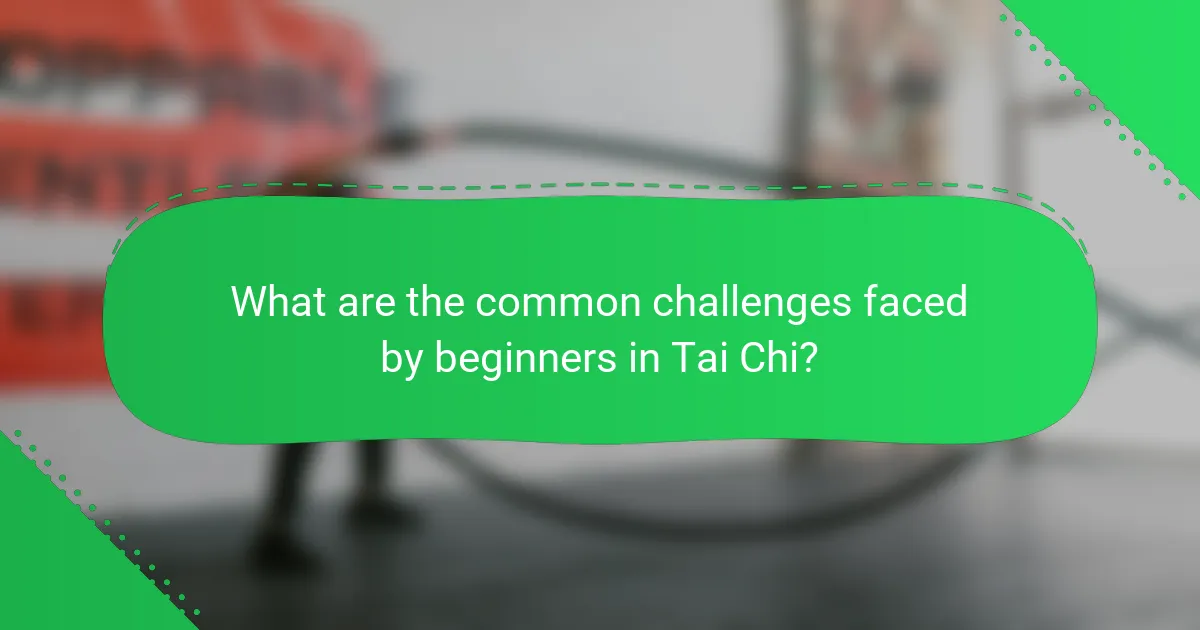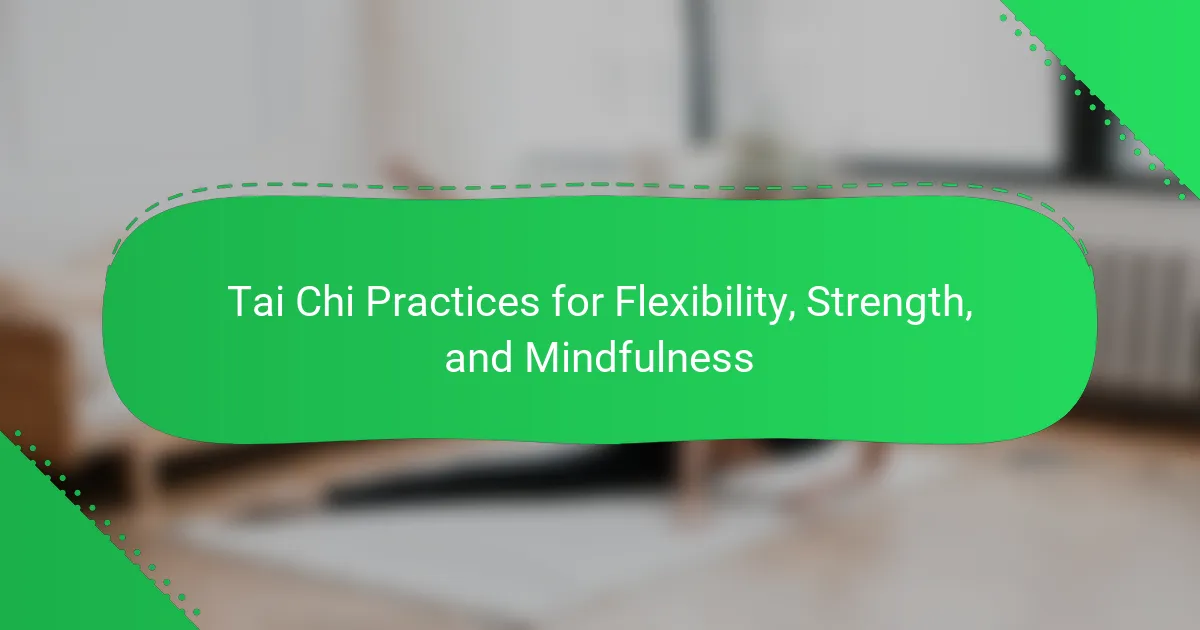Tai Chi offers significant benefits for enhancing flexibility, strength, and mindfulness. This practice improves joint mobility and muscle relaxation, while also building foundational strength for better balance. Mindfulness is cultivated through slow movements and deep breathing, promoting emotional well-being. Various regional styles and common beginner challenges shape the practice, emphasizing the importance of consistent engagement and proper technique.

How does Tai Chi enhance flexibility?
Tai Chi enhances flexibility through slow, controlled movements that stretch muscles and improve joint mobility. This practice encourages deep breathing and mindfulness, which further aids in relaxation and muscle tension release. Regular participation can lead to increased range of motion and better overall body alignment. Studies show that Tai Chi can improve flexibility in individuals of all ages, particularly benefiting older adults by reducing stiffness and enhancing balance.
What specific movements improve flexibility in Tai Chi?
Tai Chi movements that enhance flexibility include the “Cloud Hands,” “Grasp the Bird’s Tail,” and “Single Whip.” These flowing exercises promote muscle elongation and joint mobility. “Cloud Hands” involves lateral arm movements that stretch the torso, while “Grasp the Bird’s Tail” incorporates deep lunges for hip flexibility. “Single Whip” combines arm and leg movements that improve overall flexibility and balance. Regular practice of these movements can lead to increased range of motion and reduced stiffness.
Which Tai Chi forms are best for increasing flexibility?
Tai Chi forms that enhance flexibility include the Yang and Sun styles. These styles emphasize fluid movements and deep stretching. The Yang style, particularly the 24-form, integrates gentle transitions that promote joint mobility. The Sun style incorporates agile steps that further improve flexibility. Regular practice of these forms can lead to increased range of motion and reduced muscle tension.
How does flexibility gained from Tai Chi impact daily life?
Flexibility gained from Tai Chi significantly enhances daily life by improving mobility and reducing the risk of injury. Practicing Tai Chi fosters better posture and balance, which can lead to increased confidence in physical activities. Enhanced flexibility allows for smoother movements in everyday tasks, such as bending, reaching, or lifting. Additionally, the mindfulness aspect of Tai Chi promotes mental clarity and stress reduction, contributing to overall well-being. Regular practice can lead to long-term benefits, including greater resilience against age-related stiffness and improved joint health.

What role does strength play in Tai Chi practices?
Strength plays a crucial role in Tai Chi practices by enhancing stability and improving overall balance. Increased strength supports the slow, controlled movements characteristic of Tai Chi, allowing practitioners to maintain proper posture and alignment. This foundational strength also aids in injury prevention and promotes joint health. Furthermore, the integration of strength training within Tai Chi can lead to improved muscle tone and endurance, enriching the overall practice experience.
How can Tai Chi build muscle strength effectively?
Tai Chi effectively builds muscle strength through controlled movements and resistance training. This practice engages various muscle groups, promoting endurance and stability. Consistent training enhances core strength, flexibility, and balance, which are essential for overall muscle development. Studies show that regular Tai Chi practitioners experience significant improvements in muscle strength and functional fitness.
Which Tai Chi techniques target specific muscle groups?
Tai Chi techniques effectively target specific muscle groups, enhancing flexibility, strength, and mindfulness. Techniques such as “Grasp the Bird’s Tail” engage the legs and core, while “Wave Hands Like Clouds” focuses on shoulder and arm flexibility. “Single Whip” strengthens wrist and forearm muscles, and “Brush Knee and Push” targets the thighs and hips. Each movement promotes balance and coordination, contributing to overall muscle development.
How does strength acquired from Tai Chi benefit overall health?
Strength acquired from Tai Chi enhances overall health by improving muscle tone, balance, and flexibility. These benefits reduce the risk of falls and injuries, particularly in older adults. Tai Chi promotes better posture and alignment, which can alleviate chronic pain. Additionally, the practice fosters mindfulness, leading to reduced stress and improved mental well-being. Regular participation can result in increased stamina and vitality, contributing to a higher quality of life.

In what ways does Tai Chi promote mindfulness?
Tai Chi promotes mindfulness through slow, deliberate movements that enhance focus and awareness. Practitioners engage in deep breathing, which calms the mind and fosters a meditative state. This practice encourages present-moment awareness, reducing stress and anxiety. Regular participation can lead to improved emotional regulation and a greater sense of well-being.
What techniques in Tai Chi foster a mindful state?
Tai Chi techniques that foster a mindful state include slow, deliberate movements and focused breathing. These practices enhance awareness of the body and promote relaxation. The integration of posture and alignment encourages mental clarity, while the meditative aspect of Tai Chi helps cultivate inner peace. Regular practice can lead to improved emotional regulation and reduced stress.
How does mindfulness in Tai Chi differ across cultures?
Mindfulness in Tai Chi varies across cultures primarily in its emphasis and practice. In Chinese culture, mindfulness focuses on harmonizing body and mind through slow, deliberate movements. In contrast, Western adaptations often emphasize physical fitness and stress relief, sometimes at the expense of traditional mindfulness principles.
Cultural context shapes how practitioners experience mindfulness. For example, in Taiwan, Tai Chi is often practiced in parks, fostering community and social connection, enhancing mindfulness through shared experience. In Western contexts, classes may prioritize individual achievement, which can shift the focus from collective mindfulness to personal goals.
Additionally, unique attributes influence practice styles. In Japan, Tai Chi integrates Zen principles, emphasizing breath and meditation, promoting a deeper state of mindfulness. In the U.S., diverse interpretations include elements from yoga and Pilates, which can dilute traditional mindfulness aspects.
These cultural differences highlight the adaptability of Tai Chi while preserving its core benefits of flexibility, strength, and mindfulness.
What are the mental health benefits associated with mindful Tai Chi practice?
Mindful Tai Chi practice offers significant mental health benefits, including reduced anxiety and enhanced emotional regulation. Research indicates that regular practice can improve overall mood and decrease symptoms of depression. The meditative aspects of Tai Chi promote mindfulness, fostering a greater sense of present-moment awareness. This practice also encourages relaxation, which can lead to better stress management and improved cognitive function. Furthermore, the gentle movements enhance body awareness, contributing to a positive self-image and mental clarity.

How do Tai Chi practices vary across different regions?
Tai Chi practices vary significantly across regions, influenced by cultural traditions and local philosophies. In China, traditional styles emphasize martial applications, while Western adaptations often focus on health and wellness.
In Taiwan, practitioners incorporate fluid movements and breathing techniques to enhance mindfulness and relaxation. Conversely, in the United States, Tai Chi is frequently practiced in community centers, emphasizing flexibility and stress reduction.
Regional variations also include different forms, such as Chen, Yang, and Wu styles, each with unique attributes. For example, Chen style features explosive movements, while Yang style is characterized by its gentle, flowing motions.
These differences highlight how Tai Chi adapts to meet the needs of various communities, promoting physical and mental well-being through diverse practices.
What are the unique styles of Tai Chi practiced in various cultures?
Various cultures practice unique styles of Tai Chi, each emphasizing flexibility, strength, and mindfulness. The most notable styles include Yang, Chen, Wu, and Sun.
Yang style focuses on slow, flowing movements that enhance flexibility and balance. Chen style integrates explosive power and agility, promoting strength through dynamic postures. Wu style is characterized by its compact movements and lower stances, emphasizing mindfulness and stability. Sun style combines elements of Tai Chi with martial arts, enhancing both physical and mental well-being.
These styles reflect the cultural nuances and philosophies of their origins, showcasing Tai Chi’s adaptability across different societies.
How do cultural interpretations of Tai Chi affect practice outcomes?
Cultural interpretations of Tai Chi significantly influence practice outcomes by shaping participants’ beliefs and expectations. Different cultures emphasize various aspects of Tai Chi, such as its martial roots, health benefits, or meditative qualities. For instance, in Western contexts, practitioners may focus more on physical fitness and stress relief, while in Eastern traditions, the emphasis might be on spiritual growth and harmony. These differing perspectives can affect motivation, engagement, and perceived effectiveness of the practice, ultimately impacting flexibility, strength, and mindfulness outcomes. Cultural context also determines the social environment in which Tai Chi is practiced, influencing group dynamics and support systems that enhance learning and retention.

What are the common challenges faced by beginners in Tai Chi?
Beginners in Tai Chi often face challenges such as difficulty in mastering movements, lack of balance, and issues with focus. These obstacles can hinder the development of flexibility, strength, and mindfulness.
One common challenge is the complexity of Tai Chi forms. Beginners may struggle to remember sequences and execute them correctly. This can lead to frustration and decreased motivation.
Another challenge is maintaining balance. As Tai Chi emphasizes slow, controlled movements, beginners may find it hard to stabilize themselves, especially during transitions.
Focus and mindfulness are also difficult for newcomers. The practice requires mental presence, and distractions can disrupt the flow of movements, impacting overall performance and enjoyment.
How can beginners overcome initial obstacles in Tai Chi practice?
Beginners can overcome initial obstacles in Tai Chi practice by focusing on patience, consistency, and proper guidance. Establish a regular practice schedule to build muscle memory and enhance flexibility. Seek instruction from experienced practitioners to ensure correct posture and technique. Start with basic movements to develop confidence and gradually progress to more complex forms. Emphasize mindfulness during practice to cultivate mental clarity and reduce frustration.
What resources are available for new Tai Chi practitioners?
New Tai Chi practitioners can access various resources to enhance their practice. Online platforms offer instructional videos and tutorials. Local community centers often provide classes led by experienced instructors. Books and manuals on Tai Chi techniques are widely available. Mobile apps can guide users through routines and track progress. Additionally, joining Tai Chi groups or forums fosters community support and shared learning experiences.

What expert tips can enhance your Tai Chi practice for flexibility, strength, and mindfulness?
To enhance your Tai Chi practice for flexibility, strength, and mindfulness, focus on consistent practice, mindful breathing, and proper alignment. Incorporate dynamic movements to improve flexibility and strength, such as deep stances and flowing transitions. Mindfulness can be cultivated through focused attention on your movements and breath, creating a meditative state. Practicing in a quiet environment can further enhance your experience, allowing for deeper connection to the body and mind.
